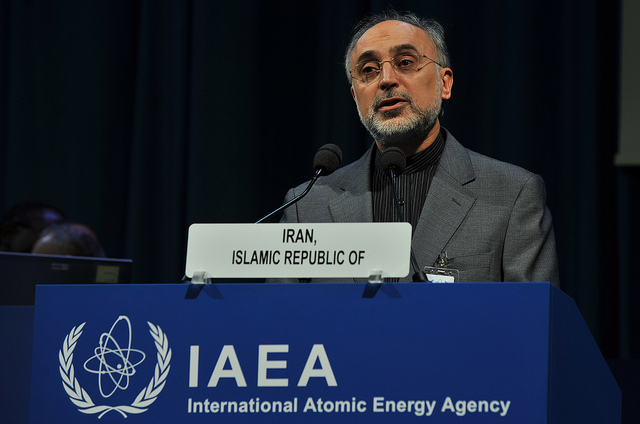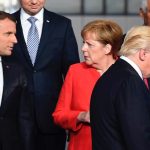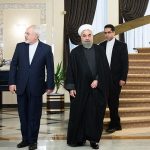by Derek Davison
The International Atomic Energy Agency (IAEA) is reporting that Iran has so far complied with its obligations under the terms of the Joint Comprehensive Plan of Action (JCPOA), which went into effect in January and limits Iran’s ability to produce nuclear weapons. The IAEA report, which is confidential but was apparently shown to the Reuters news agency, “did not point to any violations in Tehran’s observance of the deal”:
“Throughout the reporting period, Iran had no more than 130 metric tonnes of heavy water … Iran’s total enriched uranium (up to 3.67 percent purity) stockpile did not exceed 300 kg,” the report said, citing the nuclear deal’s limits on the two substances.
The IAEA report appears to contradict last week’s claims by the Institute for Science and International Security (ISIS), led by former IAEA inspector David Albright that Iran had been granted several “exemptions” to its JCPOA obligations. Those exemptions allegedly allowed Iran to meet its obligations by the date of the deal’s implementation. Per Reuters:
Earlier this month, a U.S. think-tank said Iran had been secretly allowed to overstep certain thresholds in order to get the deal through on time, but a diplomat said no limits had been exceeded apart from one incident which the agency reported in February.
The Institute for Science and International Security think-tank, headed by a former IAEA inspector, said one of the secret concessions exempted unknown quantities of low-enriched uranium contained in liquid, solid and sludge wastes.
It also said Iran had been allowed to keep operating 19 radiation containment chambers more than set out in the deal. These so-called “hot cells” are used for handling radioactive material but can be “misused for secret, mostly small-scale plutonium separation efforts,” it said.
The diplomat in Vienna said any hot-cell activity that could be used to breach limits would be reported by the IAEA, which it had not done.
ISIS, which often—but dubiously—claims to be “objective” with respect to the JCPOA, did not appear to have commented on the new IAEA report at the time this piece was being written. It’s not clear how, or even if, the anti-JCPOA community will react to the IAEA’s apparently positive assessment of Iran’s behavior under the treaty.
Update
The AP’s Vienna bureau chief, George Jahn, has weighed in with his own report on the IAEA’s findings. In Jahn’s interpretation, though the IAEA found Iran to be in compliance with the JCPOA, Tehran may nevertheless be perpetrating nefarious deeds even as we speak:
But touching on one potentially sensitive area, the International Atomic Energy Agency said in a review issued Thursday that Iran had begun manufacturing rotor tubes for centrifuges, the spinning machines used to enrich uranium. Iran is allowed to make the parts, but only under certain conditions.
To reiterate, the IAEA says that Iran has complied with its obligations under the JCPOA, so it seems that those “certain conditions” must have been met. But Jahn, whose objectivity when it comes to Iran has been called into question in the past, nevertheless opted to portray the manufacturing of these rotor tubes in the scariest possible light:
The agency needs to keep a close eye on how many rotor tubes are being made and for what models of centrifuges to make sure they are being produced only in quantities and for machines allowed under the 2015 nuclear agreement that sets a schedule for when and how many advanced centrifuges can be tested.
Any overproduction could hint at possible plans by Iran to expand advanced centrifuge testing beyond pact limits. That could be a significant issue, considering enriched uranium is a potential pathway to nuclear arms because more technically sophisticated models can enrich the uranium much more quickly than Iran’s present mainstay centrifuges.
The reaction to the IAEA report among JCPOA opponents now seems clearer: ignore the topline finding that Iran is in compliance and instead focus on the possibility that maybe, someday, under certain conditions, its manufacture of centrifuge parts could perhaps be a problem.
Update Two
Later in the day on Friday, ISIS responded to the IAEA report critically, saying that it “continues to lack critical information”:
The IAEA reporting continues to lack critical technical details about implementation of the agreement. This lack of information in the IAEA reports combined with the secrecy surrounding the decision-making of the Joint Commission is a serious shortcoming in the implementation of the JCPOA and erodes support for this important deal.
ISIS’s argument seems to be twofold: first, that the declared absence of any evidence that Iran is not complying with the JCPOA is itself evidence that Iran is not complying with the JCPOA:
The IAEA reports that Iran’s total enriched uranium stockpile “did not exceed 300 kg of UF6 enriched up to 3.67% U-235 (or the equivalent in different chemical forms).” Notably the IAEA avoided detailing in its report the quantities of any forms that we reported may have been exempted by the Joint Commission and allowed to not count against the JCPOA’s 300 kg cap on low enriched uranium. The exempted LEU is reportedly in forms that render it “unusable” for further enrichment. However, the basis for such an important determination is not available publicly and requires greater scrutiny.
And second, that while Iran may be operating within the parameters of the nuclear deal, it’s somehow going about it in a disreputable way:
Iran is producing more heavy water than expected. The IAEA reports that the Arak heavy water production plant has a nominal design capacity of 16 tonnes of nuclear-grade heavy water per year. However, the plant is exceeding this nominal capacity by a factor of two. According to the last IAEA report, “On 9 May 2016, the Agency verified that Iran’s stock of heavy water had reached 116.7 metric tonnes.” On August 30, 2016, the value was 126.5 tonnes, according to the current report. Assuming that no heavy water has been sent to Oman since May 9, 2016, the net amount produced in this 113 day period is 9.8 tonnes, or 0.87 tonnes per day. This extrapolates to an annual rate of 31.7 tonnes, about double the nominal annual production value given by the IAEA. The IAEA does not discuss this discrepancy in annual output.
The JCPOA restricts Iran to stockpiling up to 130 metric tons of heavy water, so at 126.5 tons it’s still in compliance with the deal.
Photo: Ali Akbar Salehi, head of Iran’s Atomic Energy Organization, courtesy of IAEA Imagebank via Flickr.





